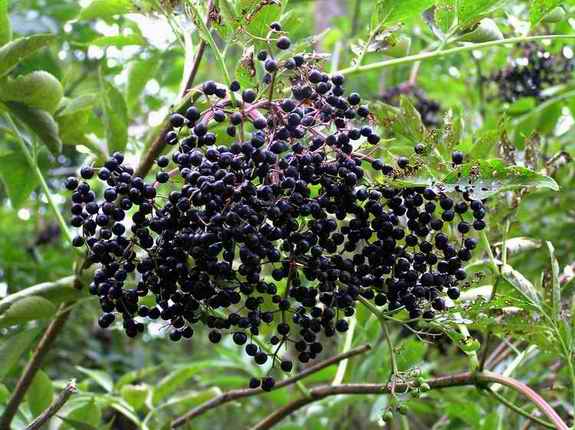|
Return to Hiker's Notebook Home Page
Common Name: Elderberry, American elder, Common elder, Black elder, European elder, Black-berried alder, Sauco (Spanish), Schwarzer holunder (German), Sureau noir (French), Old lady, Pipe tree - Elder is of uncertain origin, stemming from the Indo-European root el, as in elm, and related to the etymology of alder, another type of tree.
Scientific Name: Sambucus canadensis - The generic name is from the Latin sambuca, which is a harp-like stringed instrument that was made from the wood of the elder. The species name is a Latinized geographic reference to Canada.
The elderberry fruit is produced by several species of elders that are relatively fast growing shrubs or small trees. There are about thirty species that are indigenous to temperate regions of both the northern and southern hemispheres. The most characteristic feature is the broad, flat-topped cyme that bears the berries, which range in color from red to dark blue. The American elder is native to eastern North America, even though the species name is S. canadensis. The common elder S. nigra is frequently treated as a representative for the genus, as it is found in both Europe and North America and has a number of variants.
The wood of the elder is relatively hard; it has been used to make a variety of items that take advantage of this property including combs, spindles and pegs. The generic name Sambucus suggests that it was used in Europe for the manufacture of musical instruments that required strength to hold strings in tension, such as the harp (sambuca). The stems of the shrub have thick pith that can readily be removed to create a hollow tube. Flutes, blowpipes and pipe stems were thus fashioned from the branches, the common name Pipe tree a vestige of this application.
The berries and flowers of the elder have been a prime ingredient in a wide variety of beverages in Europe for centuries, likely due at least in part to their reputed medicinal properties. An elderberry brandy is made in Hungary requiring one hundred pounds of fruit per liter; In Italy, sambuca is made by adding elderberries and anise to alcohol. Socata is a soft drink that is made from a combination of elderberries and lemon that is reputed to be very popular in Romania. Elderberry wine is made from either the flowers or the berries; its use as the lethal conveyance for the poison in the classic 1944 Frank Capra black comedy Arsenic and Old Lace the source for its notoriety.
As an edible fruit, elderberries are highly nutritious; they contain nearly ten times as much Vitamin A and Vitamin C as grapes; they are sometimes given the sobriquet Englishman's grapes. Raw fresh elderberries have an unpleasant, mephitic smell that is dispelled by cooking to make jam, jelly, syrup and pie filling. One pint of elderberries and one pint of claret are combined with mace, peppercorns, and cloves to make a sauce called pontack that is served with liver. The entire flower cluster is dipped in batter and fried to be eaten directly or as an additive to either pancakes or fritters.
Some caution must be exercised in the consumption of products from the elder. The raw/unripe fruit and, to a lesser extent, the bark and leaves, contain the glycoside (sugar derivative) sambunigrin, which contains cyanide. Instances of cyanide poisoning have been reported, the symptoms ranging from gastrointestinal distress and diarrhea to a general feeling of debility. Cooking the berries dispels the cyanide toxicity.
The elderberry has long been used for a variety of medicinal applications. The elder tree was considered holy in medieval Europe on account of its reputed salubrious properties in the restoration and maintenance of good health. The flowers and the leaves have traditionally been used to relieve pain, applied externally in a sitz bath. Concentrated syrup from the berries was used in West Virginia as a remedy for colds and flu. A cream was made from the flowers as a salve to be applied to the hands at night. Native Americans used a poultice made from the leaves and bark to treat sores, bruises and sprains and to reduce the swelling due to a bee sting.
The medicinal properties of the elderberry flower and fruit are recognized in modern medicine. The flowers contain compounds that improve the immune function, particularly in combination with their high levels of Vitamin C. They are prepared as a tea to break a fever and to stimulate sweating, in addition to a wide variety of other conditions including bladder and kidney infections, headaches, indigestion, and rheumatism. Clinical studies have shown that the extracts of the elderberry are effective in the treatment of colds and flu; the flowers have been approved for use in Germany to ameliorate the symptoms of a cold. Numerous commercial products are sold as cold remedies that have the elderberry as the primary ingredient, notably Sambucol which has been evaluated as a treatment for the notorious avian flu virus H5N1. |
